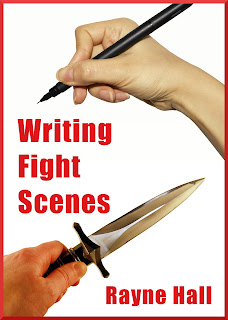- by Tara Maya
Guest Post: ZINGERS AND SWORD-PLAY: How to Write Sabre-Sharp Dialogue for Fight Scenes
Rayne Hall has published more than forty books under different pen names with different publishers in different genres, mostly fantasy, horror and non-fiction. Recent books include Storm Dancer (dark epic fantasy novel), Six Historical Tales Vol 1, Six Scary Tales Vol 1, 2 and 3 (mild horror stories), Six Historical Tales(short stories), Six Quirky Tales (humorous fantasy stories), Writing Fight Scenes and Writing Scary Scenes (instructions for authors).
She holds a college degree in publishing management and a masters degree in creative writing. Currently, she edits the Ten Tales series of multi-author short story anthologies:Bites: Ten Tales of Vampires, Haunted: Ten Tales of Ghosts, Scared: Ten Tales of Horror, Cutlass: Ten Tales of Pirates, Beltane: Ten Tales of Witchcraft, Spells: Ten Tales of Magic and more.
Her short online classes for writers intense with plenty of personal feedback. Writing Fight Scenes, Writing Scary Scenes, Writing about Magic and Magicians, The Word Loss Diet and more.
For more information about Rayne Hall go to her website.
Readers love it when the fighters spar with words as well as with weapons and trade zingers at the same time as sword blows.
In real life fighting, however, the opponents seldom talk. Panting with effort, they don’t have breath to spare for verbal banter. Focused on different action every fraction of a second, dodging sword blows, trying to get their own hits in, they aren’t able to compose articulate statements, let alone think of profound observations and witty repartees.
The trick is to create an illusion of reality. Here are some techniques for sabre-sharp dialogue which entertains and sounds real.
1. Put most of the verbal sparring at the beginning of the fight scene. Let the fighters taunt each other before they draw their weapons.
2. Use sentences which are shorter than six words. Short sentences and sentence fragments convey the out-of-breath state.
The following version, with normal-length sentences, sounds unrealistic during a fight:
“Now that you’ve had a taste of my sword, will you give up and surrender to my superior strength?”
“Never in my life will I surrender to one as evil as you. Do to me what you will, but I will not submit.”
“Then you must take the consequences of your choice.”
Whereas this version sounds real:
“Give up?”
“Never.”
“Then take this!”
3. If the pace of the action slows, if the opponents stop fighting for a moment, that’s a good place for inserting dialogue.
4. Although “Ugh”, “Argh” and “Ouch” are realistic noises during a fight, they look silly in a novel, so don’t use them.
5. Does your hero have a catchphrase which he uses elsewhere in the novel? The fight scene is a good place to repeat it.
6. Once the fighting is over, the victor delivers a parting comment which can be funny or profound (or better still, funny as well as profound).
FAMOUS EXAMPLES
You may want to watch clips from famous film fights to see how the scriptwriters have handled the challenge of dialogue.
Sanjuro:This scene is very realistic. The opponents talk a lot before the fight – indeed, one of them tries to talk the other out of fighting – and the survivor makes a profound comment afterwards. There’s no talking during the fight which is indeed very brief. Worth watching if you have the DVD, unfortunately not on YouTube due to copyright reasons.
The Princess Bride: Inigo Montoya vs the Man in Black. A fun entertaining fight scene, famous for its dialogue zingers. All this clever talking is highly implausible, but delightful, and viewers love it. Almost every sentence is witty and memorable. Alternatively, you may want to read the book on which the film is based, to see how the novelist handled it.
The Princess Bride: Inigo Montoya vs Count Rugen. Another scene from the famous book and film. This one includes one of the best-loved (and longest) catchphrases in movie history.
The Mask of Zorro (1940 version). Observe how most of the dialogue takes place before the actual fighting begins, and during brief pauses in the action. Also note how some of the dialogue comes from the bystander, and how the dialogue reflects the fighter’s personalities. Again, worth watching if you have the DVD, unfortunately not on YouTube due to copyright reasons.
If you have questions about writing dialogue for fight scenes, or want to discuss the craft of fight scene writing or bounce ideas off me, post a comment. I’ll be around for a week and will respond.

